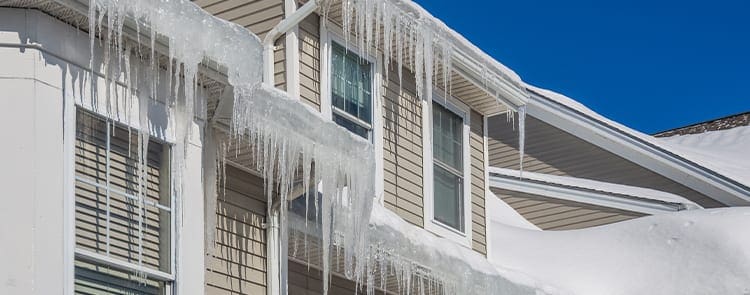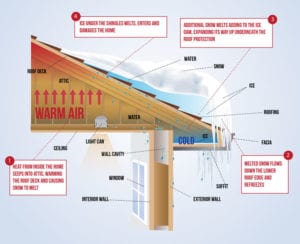Blogs
What Is An Ice Dam?
2/6/2020

Ice dams are a fact of life in the midwest, but they can be reduced and even eliminated with proper insulation and venting.
 Ice dams (and icicles) form when the snow melts, runs down your roof and refreezes near the edge. This only occurs when part of your roof warms to above 32 degrees, warm enough to melt the snow, while the roof edge remains below freezing. The heat from inside the home seeps into the attic, warming the roof deck and causing snow to melt. The melted snow then flows down the lower roof edge and refreezes. Additional snow melts adding to the ice dam, expanding its way up underneath the roof protection. Ice under the shingles melts, enters and damages the home.
Ice dams (and icicles) form when the snow melts, runs down your roof and refreezes near the edge. This only occurs when part of your roof warms to above 32 degrees, warm enough to melt the snow, while the roof edge remains below freezing. The heat from inside the home seeps into the attic, warming the roof deck and causing snow to melt. The melted snow then flows down the lower roof edge and refreezes. Additional snow melts adding to the ice dam, expanding its way up underneath the roof protection. Ice under the shingles melts, enters and damages the home.
The heat loss from poor insulation in your home causes the snow to melt and then re-freeze as it hits the cold roof overhang. The colder it is the more melting snow and the greater buildup of ice. This is referred to as an ice dam.
So What’s the Problem With Ice Dams?
The ice, as it cycles through freezing and thawing, can do significant damage to your roof in areas that you can and can’t see. After several days of melting-freezing cycles, it’s common for the melted water and ice to work up under the shingles until water enters the attic and eventually does damage to the ceilings, wall, and contents.
In cases where the ice dam goes unnoticed for an extended period of time, it can do significant damage to your house and its contents. Ice dams are problematic because they force water to leak from the roof into the building envelope (ceiling and walls). This may lead to:
- Rotted roof decking, rafters, and exterior and interior wall framing and sheathing
- Icicles form and can grow to gigantic sizes. These icicles, and the large mass of ice behind them, break off and can cause roof, gutter and siding damage, possibly harm people who are unlucky enough to be underneath them when they fall off
- Reduced effectiveness of insulation. Wet insulation doesn’t work well, and chronically wet insulation will not decompress even when it dries. Without working insulation, even more heat will escape to the roof where more snow will melt, causing more ice dams which, in turn, will lead to leaks.
- Respiratory illnesses (allergies, asthma, etc.) caused by mold growth. Wet insulation or wet areas inside the home’s structure can lead to dangerous air to be circulated throughout the home.
- Peeling paint. Water from the leak will infiltrate wall cavities and cause the paint to peel and blister. This may happen long after the ice dam has melted and thus not appear directly related to the ice dam.
Prevent Leaking Air From Damaging Your Home
The two biggest culprits leading to heat loss through the roof are air leakage and poor insulation. The key takeaway to preventing ice dams is simply to stop air leakage in your home.
To keep ice dams off your roof, follow these three steps:
- Close up attic air leaks. In the average home, about one-third of the heat loss is through the ceiling into the attic. And most of that loss comes from air leaks caused by unblocked walls, gaps in drywall, and cracks around light fixtures, plumbing pipes, chimneys, access hatches, and other ceiling penetrations. Air leaks can be tough to stop. You have to climb into your attic, pull or rake back insulation, and plug the leaks using foam, caulk and other methods. Plus, low roof angles make air leaks difficult to reach.
- Measure your attic insulation level. While you’re in your attic, you’ll also want to check the depth of your attic insulation. Building codes require about 18 to 24 inches of fiberglass or cellulose. Add more if you have less than 12 inches and have had ice dam problems in the past. Blown-in cellulose, fiberglass or closed cell spray foam are usually better than hand-placed batts, because they fill more tightly around rafters, joists and other obstructions, leaving fewer gaps. It’s usually worth hiring a professional for this job; you probably won’t save much by doing it yourself.
- Add roof and soffit vents. Attic ventilation draws in cold outdoor air and flushes out warmer attic air, cooling the attic and the roof in the process. The minimum ventilation area (size of the openings) should be about 1 sq. ft. of vent per 300 sq. ft. of ceiling area (attic floor area), when half the vent area is low on the roof and half is high. Actually figuring all this out is a bit complex; you’d have to examine your existing vents to find the area of each vent. This is easier said than done. Also be sure that all vents and soffits are clear from debris and blockages like old insulation, leaves, bugs, or leaves.
Hire a Professional. We Can Help!
Of course, there’s no way to guarantee an ice dam won’t damage your home, but you can take steps to cut the chances of an ice dam forming in the first place by eliminating air leakage. Our qualified and certified experts at Service Legends will conduct a blower door test to evaluate how airtight your ceiling is and measure your insulation in your home. We will also use an infrared camera to find places in the ceiling, windows, outlets and more where there is excessive heat loss.
By stopping air leakage to mitigate ice dams, you’ll also save energy and reduce both your heating and cooling bills. Give us a call today at 515-657-6634 to schedule today!
515-657-6634Request Appointment Online
Return- January 2024
- October 2023
- September 2023
- August 2023
- January 2023
- December 2022
- November 2022
- October 2022
- September 2022
- August 2022
- July 2022
- June 2022
- May 2022
- April 2022
- March 2022
- February 2022
- January 2022
- May 2021
- November 2020
- October 2020
- September 2020
- July 2020
- June 2020
- May 2020
- March 2020
- February 2020
- December 2019
- November 2019
- September 2019
- May 2019
- April 2019
- January 2019
- December 2018
- November 2018
- October 2018
- July 2018
- October 2016
- September 2016
- August 2016
- July 2016
- June 2016
- May 2016
- April 2016
- March 2016
- February 2016
- January 2016
- December 2015
- November 2015
- October 2015
- September 2015
- August 2015
- July 2015
- June 2015
- May 2015
- April 2015
- March 2015
- February 2015
- January 2015
- December 2014
- November 2014
- October 2014
- September 2014
- August 2014
- July 2014
- May 2014
- March 2014
- February 2014
- January 2014
- December 2013
- November 2013
- October 2013
- September 2013